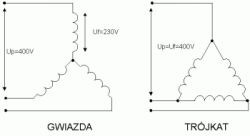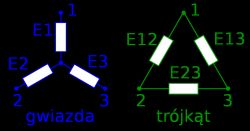I have a question about three-phase motors, and more about √3 in power, e.g. active
Because sometimes I see P= √3 Uf*If
But when I solve a problem, we suddenly use Pf= Uf*If
And I don't know why that is...
I know Up is the phase-to-phase voltage and Uf is the phase-to-phase voltage
But the task said to calculate the total active power Pc AP= √3 Uf*If it's like 1 load from 3 phases but if you add all 3 it doesn't make sense ....
Pc= 3Uf*If
As if someone could explain it to me because I have no idea when P= √3 Uf*If or P= Uf*If
Thanks in advance for your help as I have not understood this for some time

Could you explain it as simply as possible? What a boy this is
Because sometimes I see P= √3 Uf*If
But when I solve a problem, we suddenly use Pf= Uf*If
And I don't know why that is...
I know Up is the phase-to-phase voltage and Uf is the phase-to-phase voltage
But the task said to calculate the total active power Pc AP= √3 Uf*If it's like 1 load from 3 phases but if you add all 3 it doesn't make sense ....
Pc= 3Uf*If
As if someone could explain it to me because I have no idea when P= √3 Uf*If or P= Uf*If
Thanks in advance for your help as I have not understood this for some time

Could you explain it as simply as possible? What a boy this is



